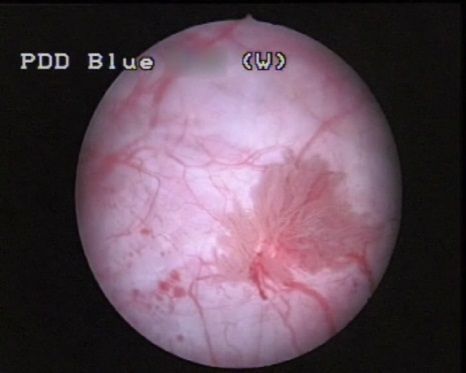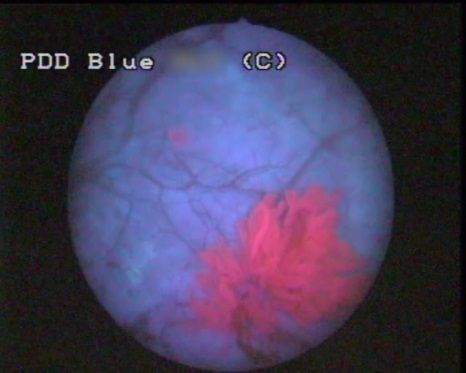Cysview-Assisted Transurethral Resection of Bladder (TURB)
During a routine check-up with his primary-care physician and an irregular urinalysis, a 61-year-old man was found to have microhematuria. After the microhematuria recurred for five months, the patient was referred to a urologist for a cystoscopy.
Clinical History1
During a routine check-up with his primary-care physician and an irregular urinalysis, a 61-year-old man was found to have microhematuria. After the microhematuria recurred for five months, the patient was referred to a urologist for a cystoscopy. The patient had a smoking history of approximately one pack a day for 15 years, but had no history of bladder neplasia or further urological problems.
Findings and Diagnosis
A white light cystoscopy was performed, which revealed a singular papillary tumor (Ta G2, low grade). Until recently, the standard option for diagnosis of bladder cancer in the US was a white light cystoscopy2; however, a blue light option that has been proven to significantly improve the accuracy of bladder cancer detection is now available.3 When a CysviewTM-assisted TURB blue light cystoscopy was used during initial resection, it revealed a second, smaller papillary tumor (Ta G1, low grade) that was overlooked by the white light cystoscopy. Cysview is an optical imaging agent for use in the cystoscopic detection of non-muscle invasive papillary cancer of the bladder in patients with known or suspected lesion(s) on the basis of a prior cystoscopy.
Both tumors were removed during the surgery. Based on these findings, a diagnosis of non-muscle-invasive bladder cancer was given and the patient was classified as low-risk. Additional tests included urine cytology that was inconclusive and an ultrasound of the kidneys and urinary bladder that showed no abnormal findings.
Treatment and Follow-up
The overall goal of treatment was to prevent recurrence of the non-muscle-invasive bladder cancer. The patient was given a post-operative dose of mitomycin C 40 mg (the standard of care), which was followed by six weeks of the same dosage. The patient was then assessed after three months of treatment and no additional tumors were found. It was determined that the resection was complete, so no further surgeries were needed.


Maximilian Burger, MD, FEBU, is associate professor of urology at the University of Regensburg, Germany.
[1] Burger M. Case study: Hexvix- assisted TURB. Dept. of Urology, Caritas St. Josef Medical Centre, University of Regensburg.
[2] U.S. Department of Health and Human Services, National Institutes of Health. What You Need to Know About Bladder Cancer. NIH Publication No. 10-1559. National Cancer Institute Web site. http://www.cancer.gov/pdf/WYNTK/WYNTK_bladder.pdf. Revised July 2010. Printed August 2010. Accessed January 5, 2011.
[3] Stenzl A, Burger M, et al. Hexaminolevulinate Guided Fluorescence Cystoscopy Reduces Recurrence in Patients With Nonmuscle Invasive Bladder Cancer. J. Urol. 2010;1907-1914.
What New Research Reveals About Novice Use of AI-Guided Cardiac Ultrasound
April 4th 2025In a study recently presented at the American College of Cardiology (ACC) conference, researchers found that novice use of AI-guided cardiac ultrasound after an AI-enabled electrocardiogram increased the positive predictive value for reduced left ventricular ejection fraction (LVEF) or aortic valve stenosis by 33 percent.
The Reading Room Podcast: Current Perspectives on the Updated Appropriate Use Criteria for Brain PET
March 18th 2025In a new podcast, Satoshi Minoshima, M.D., Ph.D., and James Williams, Ph.D., share their insights on the recently updated appropriate use criteria for amyloid PET and tau PET in patients with mild cognitive impairment.
Study with CT Data Suggests Women with PE Have More Than Triple the One-Year Mortality Rate than Men
April 3rd 2025After a multivariable assessment including age and comorbidities, women with pulmonary embolism (PE) had a 48 percent higher risk of one-year mortality than men with PE, according to a new study involving over 33,000 patients.
GE HealthCare Debuts AI-Powered Cardiac CT Device at ACC Conference
April 1st 2025Featuring enhanced low-dose image quality with motion-free images, the Revolution Vibe CT system reportedly facilitates improved diagnostic clarity for patients with conditions ranging from in-stent restenosis to atrial fibrillation.